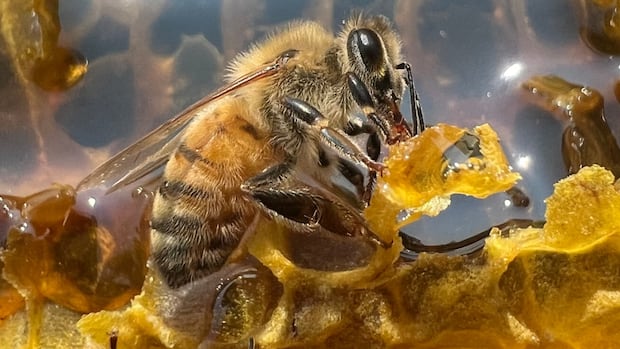Killer whales are ramming boats for fun, scientists say. A new report offers ways to protect mariners

Quirks and Quarks11:40Killer whales are likely ramming boats because they’re bored and having fun
When Renaud de Stephanis sees killer whales surround his boat off the coast of Spain, he isn’t afraid — he’s excited because it’s a chance to get some research done.
When asked how often his boats have been hit by the whales, he laughs and says, “oh, about 70 times.”
Using boats with fake rudders and underwater cameras, he and his team have been trying to learn more about why, for the last five years, the killer whales (also known as orcas) in these waters keep ramming boats, sometimes sinking them.
“They don’t care if it’s a sailboat or motorboat. They look for the rudders to break them,” said de Stephanis, a biologist and president of the Spanish conservation group CIRCE. “They just push it with their head until they break it and that’s it.”
According to the GT Atlantic Orca, which tracks the incidents, at least 673 boats have reported being rammed by this pod of whales near Spain since 2020. While there have been no injuries to humans, two Moroccan fishing vessels and five sailboats ended up sinking, including a 50-foot sailboat just a few weeks ago.
“It was perplexing because it’s something that, having studied killer whales on the West Coast of Canada for many decades, I’ve never heard of this kind of behaviour at all,” said John Ford, research scientist emeritus at Fisheries and Oceans Canada’s Pacific Biological Station in Nanaimo, B.C.
De Stephanis and Ford are part of an international network of killer whale experts who have been trying to get to the bottom of the behaviour. The group met in February at the request of the Spanish and Portuguese governments, and recently released a report of their findings.
The report concludes that the whales’ behaviour is playful, and suggests several ideas on how to stop it for the safety of the whales and humans alike.
These really shouldn’t be called attacks because they’re not attacking the boats, they’re playing with the boats.– John Ford
Internet theories of revenge are unfounded
The population of Iberian killer whales are listed as critically endangered by the IUCN, with only 40 animals left in the region. And just 14 of the whales, mostly juveniles with four mature females, are believed to be the ones causing trouble.
Soon after the incidents started in 2020, people on the internet came up with theories about why the whales were targeting boats.
“There was a lot of talk about revenge, and, oh, sink the rich,” said Naomi Rose, senior scientist for marine mammal biology at the Animal Welfare Institute, who was also part of the workshop in Madrid.
Scientists captured this pod of juvenile killer whales off the coast of Spain as they bumped the rudders of their ship. The researchers say the whales are interacting with the rudders as a form of play, and not aggression or revenge as suggested by some on social media. Video credit: Renaud de Stephanis/CIRCE (Conservación, Información y Estudio sobre Cetáceos)
But instead of laughing at the jokes, she realized that this could end up being a dangerous narrative for the whales.
“I was just worried that the funnier people found it, the more the mariners who were being targeted would get angry.”
The behaviour has been called an “attack” on boats, a term Ford rejects.
“They’re not attacking the boats, they’re playing with the boats,” he said.
Rose’s concerns are not unfounded. In recent years, mariners have been spotted shooting at the whales, pouring gasoline into the water and even dropping explosives as the whales approach.
The governments of Spain and Portugal called the meeting in February in part to see if scientists could figure out alternative solutions for mariners to evade the whales without causing harm to the animals.

Play behaviour is quite common in killer whales. Ford witnessed this first hand when studying southern resident killer whales off the coast of British Columbia, when, one summer, they decided to wear dead salmon on their heads as hats.
The scientists believe this particular pod of whales have more time to play because they are spending less time hunting for food.
“What’s happened in recent years is that the abundance of bluefin tuna has increased substantially and, as a result, the whales are spending less time foraging, and they have, essentially, more time on their hands to get involved in other behaviours,” said Ford.
Simple solution: Make the game less fun
This summer, de Stephanis and his team from CIRCE are testing different mitigation techniques on several boats near the Strait of Gibraltar to see if they can repel the whales.
One method is to have weighted lines over the side of the boat that surround the rudder area. This may repel the whales, de Stephanis says, because they look like jellyfish.
Another approach is to install small cones on the rudders, which make it uncomfortable for the whales to push with their heads.
“In our case it’s working, and all the orcas have been having a problem with that,” de Stephanis said.
Until these methods are commercially available, the report suggests the best thing for concerned mariners to do is to keep on moving if they see the killer whales nearby.
“If you stop [your boat], the problem is that you give the rudder to them and they can break it by leverage, and they can aim,” he said.

Ford adds that research has shown that the whales typically won’t chase after a boat. “If they continue driving away in their boat for two to three kilometres, the whales generally will give up.”
Rose hopes that the report can help quell rumours of whales being on the attack, and encourage people to admire these playful animals instead.
“We’re in their living room, we’re in their world, we’re in their house. We need to learn to live with them,” said Rose.
“And, you know, we really ought to start having more respect for the animals we share the ocean with.”





